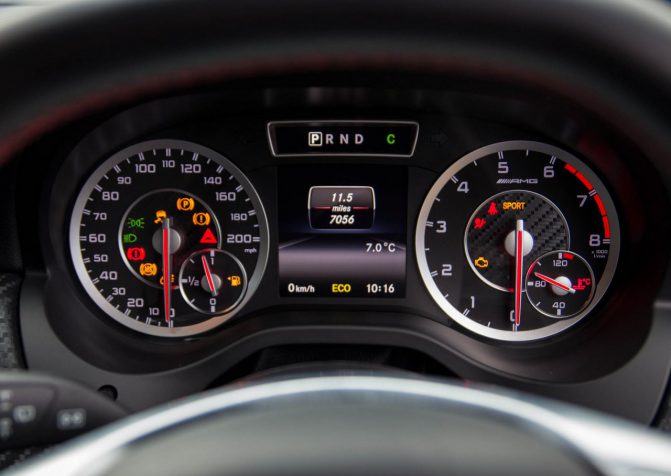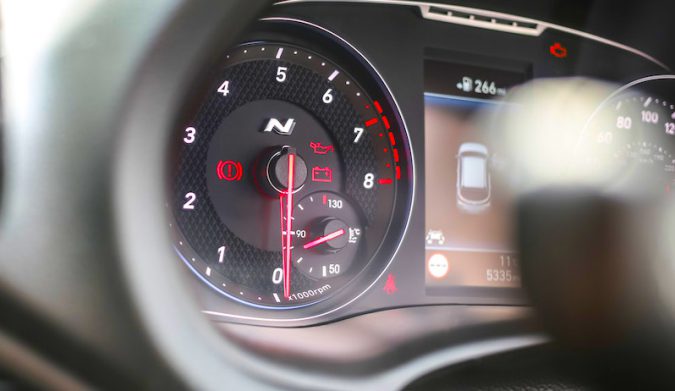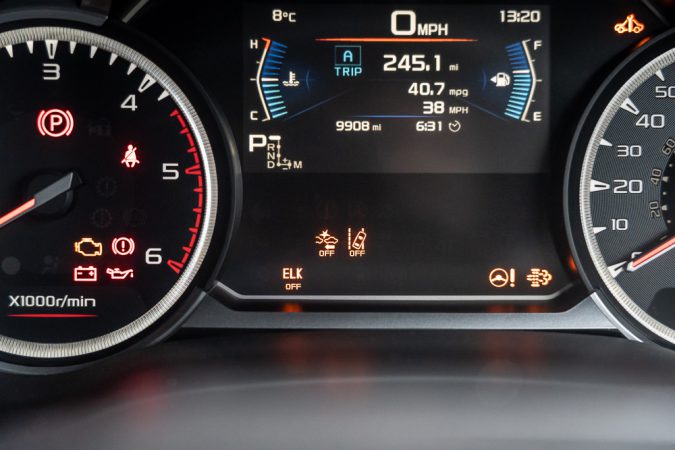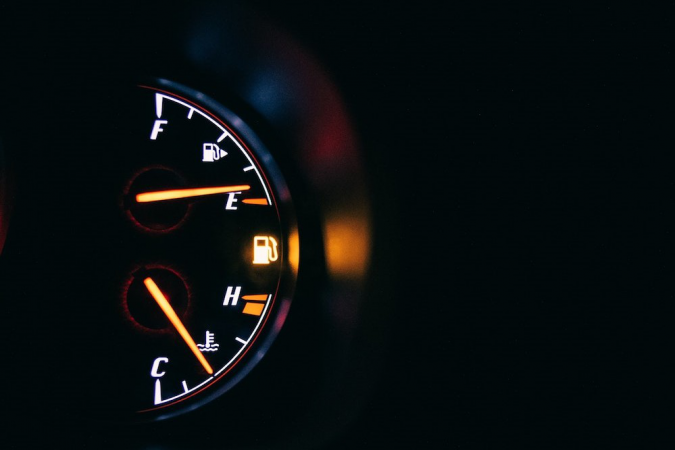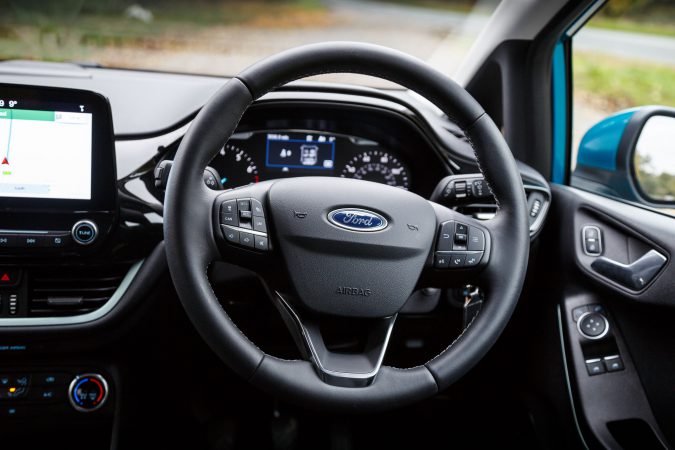Think of all the times your mood has dropped because something lit up on your car’s dashboard while you were on the road. Unfortunately, your vehicle’s dashboard is filled with lights that can and will turn on without warning. So, you may wonder what the Check Gauge light signifies.
If you notice the “Check Gauge” light flashing on your dashboard, know that a gauge or two have gone out of range. They could be the brake fluid gauge, engine oil gauge, or electrical system gauge. There’s no need to panic at first sight of this light. Simply pull over and check. There should be a gauge that has gone off. More often than not, that is what the “Check Gauge” was trying to point out.
Keep reading to learn more about the indicator, what it means and what you have to do when you see it blinking across your dashboard.
What Is A Check Gauge Light?
Manufacturers installed a set of lights and gauges to inform drives of what goes on within their vehicles. This was to ensure the owners were constantly aware of whether their cars were operating properly or not. These gauges and lights will warn drivers if a car component is malfunctioning.
Among these lights is our topic for today: the Check Gauge light, an indispensable component to the operation of a vehicle usually displayed on the dashboard. How it is shown depends on the model and brand of the vehicle.
The Check Gauge light’s job is to remind you to check the nearby gauges on the board, like battery, gas, and oil gauges. So when this warning light goes off, it’s a sign that there’s a problem with any of the other gauges.
However, if none of the gauges are lit but the Check Gauge light is still illuminated, it might be a false warning. Despite that, we suggest you get your vehicle checked by a professional. They are the ones who can say for sure that a part of your car is or isn’t functioning to its full capacity.
Where Is Check Gauge Light Located?
You can find the Check Gauge warning light on the car’s dashboard. Some vehicles feature a digital information cluster, whereas older cars have analog gauges. This entirely depends on the model and make of the car. A few brands keep their instrument panel in the middle, but most cars will have it over the steering wheel.
As all other lights and gauges linked to the Check Gauge light can be found on the dashboard, it only makes sense to position them side-by-side. Whenever you see that light on, you know that a certain gauge has crossed its limit – in real-time.
How Do Car Gauges Function?
There are two primary kinds of car gauges with unique working methods:
Electrical Gauge
Electrical gauges derive their base readings from their specific sensors. You should know where these sensors are located and where the problem can happen to get a basic understanding of their working principle. For instance, the pressure sensor can be found in the passage between the oil reservoir and engine when it comes to an oil pressure gauge.
With the help of a signal, it measures the volume of oil being transferred. A decrease in oil flow will cause a “low-pressure oil” situation. This sensor information is transmitted in electrical resistance form. The current moving through a coil calculates the resistance. When the resistance dips below a certain level, adequate current starts to cross. Thus, that particular gauge turns on.
Mechanical Gauge
The primary difference between an electrical gauge and a mechanical gauge is that the sensor is replaced by a physical measurement instrument in the latter. Coming back to the discussion of an oil pressure gauge, its working mechanism is different from a mechanical gauge. It will use a draw pipe located between the engine head and the oil reservoir.
The volume of oil going into it will show the oil pressure since the gauge’s calibration is set according to it. When it falls below a particular level, the light comes on.
As mentioned earlier, if no other warning lights are on but the Check Gauge light is one, that’s a false warning. Modern cars feature twisted and complex electrical systems. As with anything electrical, it’s possible that the system does read false signals sometimes, illuminating the Check Engine Light even when there is no need.
In this scenario, check out all the other gauges. After that, physically inspect all things – exterior and interior. For instance, many drivers report that the Check Gauge light was illuminated despite all their gauges seeming fine. But after a bit of inspection, they found some errors, like a loose gas tank cap which justifies the illuminated Check Gauge light.
Thus, the warning light can come on due to minimal malfunction; or sometimes due to a sensor malfunction. Once again, we highly recommend visiting a professional mechanic to figure it out.
Common Car Gauge Readings
The count of gauges on a vehicle’s dashboard will differ based on the car’s model and make. But, some basic gauges are more or less standard with every car. If your vehicle’s dashboard doesn’t display a particular kind of gauge, the diagnostic will generally be displayed through a warning light if there is ever an issue.
Learn about some of the more common car gauge readings. They indicate the working condition of your vehicle:
1. Speedometer
Alongside the fuel gauge, the speedometer is the most common gauge. For obvious reasons, this is a standard gauge in cars. After all, you need to know how fast you will comply with traffic rules and your safety. Old speedometers were connected to a cable going into the transmission box. However, modern speedometers universally display your driving speed via an electronic sensor that calculates wheel speed.
An important factor to remember here is that factory presets for these gauges are dependent on the car’s stock tire size. Therefore, if you use a set of aftermarket tires larger than the original set, the speedometer might give inaccurate readings. Always make sure to update your speedometer if you change the vehicle’s tire size.
2. Fuel
We mentioned before that the fuel gauge is another universally featured dashboard gauge. It is located in the fuel tank and displayed via a sensor. Due to this, the sensor can only give a fully accurate reading if the car is parked on a uniform surface.
Unless you’re very meticulous about the fuel levels in your car, the fuel gauge has surely displayed below the E at some point. This generally signals only about a gallon or two of gas left in the tank. Typically, your fuel gauge will display a warning light by this time, telling you that you have to get gas soon before you’re stranded in the middle of a highway with a car that will not move.
Not only does monitoring the fuel gauge properly make sure you get where you need to go properly, but it also ensures your vehicle’s longevity. We highly recommend always driving with ¼ of a gas tank at the very minimum. Operating your car with anything less than this amount can make the fuel pump overheat, eventually damaging the mechanism.
3. Temperature
The temperature gauge is tasked with measuring the internal temperature of the coolant (of the engine). A good driver is always aware of their vehicle’s temperature gauge, which is a crucial component of the dashboard. Any unnatural changes in temperature can end up doing serious damage to the engine.
Your vehicle’s coolant system is made to function under all conditions, but it fails to keep up in extreme heat or some older cars. If you observe the temperature gauge straying from the normal range and moving into the alarmingly hot section, stop your vehicle and allow the engine the cool down before driving again.
Some factors, ranging from a leak in the coolant system to a malfunctioning radiator, can cause the engine to overheat. It’s highly suggested to carry additional coolant in the vehicle if there’s a leak. You don’t want to be sitting in an overheated car in the middle of nowhere.
In older vehicles, the temperature gauge needle is in the middle to show that the coolant is performing fine and the engine is functioning efficiently.
Modern-day vehicles are equipped with state-of-the-art temperature gauges that give their readings in a visual/digital manner. Generally, you will see an “H” and a “C.” The “H” stands for hot, while the “C” signifies cold.
4. Tachometer
This dashboard gauge displays the engine’s revolutions per minute, or RPM. The RPM indicates how fast the car’s engine turns and is generally displayed by one digit, like 1, 2, 3, and more. You have to multiply the number by 1,000 to get the true RPM, like 1,000, 2,000, 3,000, and so on.
The tachometer is indispensable for cars that feature manual transmissions but not the most useful for vehicles with automatic transmissions. If you drive a manual transmission vehicle, keep a close eye on the tachometer, and it can keep you aware of the best times to switch gears for performance and fuel economy.
A tachometer can be a great addition for all vehicles, not just ones with standard transmissions. Like other gauges, a tachometer shows a regular range versus a dangerous range. Never turn your engine so rapidly that the gauge shifts into the danger (red) zone.
5. Oil Pressure
The oil pressure gauge measures the oil’s resistance being pumped into the engine by the oil pump. The temperature, viscosity, and oil type impact the amount of resistance.
The oil pressure gauge calculates oil pressure in pounds per square inch or psi unit. Ideally, the oil pressure gauge should read between 25 psi to 65 psi while the engine is running. Making sure your vehicle has enough oil pressure is pivotal; operating an engine with inadequate pressure, even if it’s for a short time, can severely destroy the engine, if not destroy it.
An oil pressure gauge is not as common as some other dashboard gauges. The warning light comes on when the oil pressure is very low for vehicles that do not have this gauge. Automakers highly recommend changing the oil at regular intervals to keep your vehicle operating smoothly and/or address any problems in the oil pressure system.
6. Voltmeter
Last but not least, the voltmeter is a member of a vehicle’s charging system. Although the voltmeter is very important for a car’s longevity, it’s generally more forgiving than other gauges when there’s an issue with it. Even if the system faces a problem, you can normally drive a little farther to get assistance, which may not be the case for other warning gauges. You have to halt the vehicle immediately to prevent major harm with those.
A vehicle’s voltmeter features a 12-volt system. When you start the engine, it consumes the car battery. The battery is simultaneously recharged when you drive by the engine’s activity. Once fully charged, a car battery gives a reading of 12.5 volts (usually) when the engine is off.
A voltmeter reading of 14 to 14.5 volts when the engine is running indicates a car battery in good condition. If the displayed numbers are out of this range, have the vehicle’s battery and charging system examined for damages.
On the other hand, if the ammeter reads a bit more than 0, the battery charging system is functioning fine, and the battery is charged fully. Now that we’ve provided some basic information about a handful of the most common gauges found in a car let’s get to answering questions regarding what to do about these warning gauges.
Check Gauge Light On For Different Gauges: What To Do?
The Check Gauge light is illuminated when one or more warning lights are on, but it can still give a false warning. We have prepared a list containing all the general gauges you can find in the recently manufactured cars. If any of these gauges light up, immediate action must be taken.
- Temperature Gauge: Coolant has to be refilled and check the water level in the radiator.
- Seat Belt Logo: Fasten seat belts.
- Fuel Gauge: Gas might be low, so refill is necessary.
- Air Bag Logo: Check with a mechanic as soon as possible.
- Oil Pressure Gauge: Inspect oil levels and refill as required.
- ABS Brakes Warning: Visit a mechanic; ABS isn’t functioning.
- Low Tire Pressure: Examine tire pressure and, if required, refill air.
- Brake Pad Warning: Brake pads have reached their limit and must be replaced.
- Fault Problem: The fault problem can be caused by any issue, even the minute ones. Call a mechanic in this case.
- Battery Warning: Inspect battery wiring and health and replace if needed.
Reasons Behind Check Gauge Light Turning On
There can be many reasons behind the Check Gauge warning light coming on. Usually, it will turn on when there’s a malfunction in the vehicle that has to be inspected, serviced, or repaired. It can be anything from the given and more:
- Faults with the engine
- Low engine oil level
- Overheated engine
- Loose fuel cap, or
- Malfunction in the electrical system.
Multiple gauges observe the following:
- Transmission fluid
- Brake fluid, and
- Other fluids your vehicle is using.
Any of these gauges malfunctioning will trigger the Check Gauge light. Don’t ignore these warning signs unless you want to wreck your car.
How To Deal With A Check Gauge Light
If we haven’t made it abundantly clear by now, there’s no reason to panic if this warning light suddenly illuminates your vehicle’s dashboard. Somewhere on the dashboard, there should be a lit gauge light. More likely than not, your Check Gauge light is pointing you in the direction of that warning light.
The issue can be quite simple – from the gas running out to low oil pressure. Follow the light, in this case, to tell you where the problem originated.
Perform A Full Vehicle Scan
Having a vehicle scanner makes this process so much easier. The scanner will provide specific error code(s) about where the issue is rooted. Check out this video tutorial to learn how to use one on your vehicle. Once you know which component of your car is giving you trouble, fixing it will be simpler.
Take Your Vehicle To A Diagnostic Shop
You have to bring your car to a diagnostic shop to get the precise results. The shop will perform a full scan of your vehicle with an array of powerful vehicle scanners. They can also repair the problem if they find one as these car shops tend to offer complete repair services for cars.
Inspect All Gauges Across The Dashboard
If you don’t own a vehicle scanner, make sure to inspect all the gauges across the dashboard. You should be able to find the one that’s illuminated. Even if you don’t, it will be safer to get the car checked by a professional mechanic.
How Long Can You Drive With Check Gauge Light On?
The answer depends on why the warning light came on in the first place. For something such as a low washer fluid level, you will not face too many issues and should be able to drive for as long as all other systems are working fine. But, if it happened due to any other (critical) reason, pull over when safe and examine the situation.
For example, if the warning light came on because of a warning from the TPMS, or Tire Pressure Monitoring System, you could possibly drive for an extra 100 miles. You have to maintain a low speed to nullify the effects. Make sure the Check Gauge light hasn’t come on for something like low engine oil. This is the worst problem the warning light can signal.
A flashing check light will alert you of any critical issue. Otherwise, the light will be steady, and you will know that your car is fine.
As a rule of thumb, you must immediately deal with anything regarding your safety. Worry about the engine or other systems later.
What Check Gauge Light Means In Different Cars
Different auto brands have unique orientations for their Check Gauge light. So, what might work for your vehicle may not work for your friends. These are some of the possible meanings of an illuminated warning light for some car brands.
1. Check Gauge Light: GMC Envoy
A few owners have reported that the warning light is illuminated when the car suffers from an oil pressure issue. When the pressure gets too low, the light blinks.
2. Check Gauge Light: Ford Explorer
For a Ford Explorer, the Check Gauge light turns on when one or multiple gauges need attention. The oil pressure gauge, coolant temperature gauge, fuel gauge, or engine temperature gauge can be the culprit(s).
3. Check Gauge Light: Dodge Durango
A handful of owners have claimed that the warning light on a Dodge Durango comes on when they step on the brakes. They suggest inspecting the battery voltage along with the alternator output. The reason? When you hit the brakes, you remove your foot from the gas. This is when the brake lights light up. In the process, the voltage drops, and one or two dashboard gauges go out of range. As a result, the Check Gauge light comes on.
Check Gauges Light Facts:
- The Check Gauge Light is a warning that indicates potential problems with a car’s gauges or oil pressure/coolant temperatures.
- The light is typically yellow/amber, orange, or red and appears next to the fuel gauge on the instrument cluster.
- The ‘Check Gauges’ light can mean anything from low oil pressure or charging system anomalies to a fuel tank issue due to the numerous gauges present in a vehicle.
- Savvy car owners advise immediately checking the dash to see which of the gauges is amiss, inspecting gauges for water level, brake fluid level, engine oil level, and tire pressure first as they are likely to result in an on-road emergency if not caught early on.
- Different Jeep models have low-/high-line clusters with out-of-range readings such as the coolant temperature gauge, fuel gauge, oil pressure gauge, speedometer/odometer, tachometer, and voltmeter.
- Understanding what triggers the ‘Check Gauges’ light is crucial to resolving it. Common reasons behind an illuminated light include low oil pressure, an overheated engine, faulty sensors/sending units, a loose gas cap, thermostat issues, a bad water pump, vacuum leaks, blown fuses, charging system issues, loose fan/accessory belt, mechanism malfunction, defective PCM/ECM/ECU, and non-adherence to periodic maintenance.
- Low fuel levels, ‘Check Bulbs’ warning, and a bad key cylinder, ignition switch, or instrument cluster, can also set off the ‘Check Gauges’ light.
- To diagnose and fix the issue, car owners must be familiar with the type of instrument panel their Jeep has and its circuit schematic, which is vital in the proper diagnosis of a triggered Check Gauge light.
- A car’s PCM/ECM/ECU has Diagnostic Trouble Codes saved in its repository that tremendously help in identifying the cause of the problem.
- If all else fails, seek help from a competent mechanic.
Conclusion
In summary, when the Check Gauge light turns on in your dashboard, there can be one or two other gauges going out range. Many gauges littered across the dashboard observe the various substances and components to help you operate your vehicle without any problems.
So, the illuminated warning light can mean something wrong with the brake fluid gauge, the electrical system gauge, the engine oil gauge, or any other gauge you see on the dashboard.
When you see the warning light go off, your first impulse should be to pull over at a safe location. Conduct preliminary checking and troubleshooting to confirm what’s wrong. To be on the safe side, remember to consult with a qualified mechanic.

